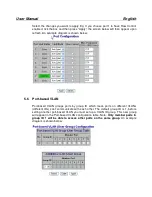
User Manual English
Protocol configuration messages before attempting a reconfiguration. Enter a number
between 6 & 40. (default is 20)
Forward Delay:
The number of seconds a port waits before changing from Spanning-
Tree Protocol learning and listening state to the forwarding state. Enter a number
between 4 & 30. (default is 15)
Force Version:
Normal: use RSTP/Compatible: compatible with the old STP protocol
Port Configuration
Aggregations:
Enable/Disable the RSTP protocol on aggregation links
Protocol Enabled:
Enable/Disable the RSTP protocol per port basis
Edge:
Enable/Disable to expect a port to be an edge port (an end station) or a link to
another STP device
Path Cost:
A value on a port the switch uses to determine which port are the
forwarding ports. The lowest number is forwarding ports. The value can be set from 1
to 200000000 or “auto” to be automatically generated
5.14 IGMP
The Internet Group Management Protocol (IGMP) is an internal protocol of the
Internet Protocol (IP) suite. IGMP can manage the multicast traffic if the members
(switches, router or other network devices) of the group support IGMP. This switch
provides IGMP snooping feature to detect IGMP queries, report packets and
manages the IP multicast traffic through the switch. This feature can limit the
forwarding multicast frames only to those ports that are a member of multicast group.
Only IPv4 IGMP frames are recognized for this system.
IGMP Enabled:
Globally enable/disable IGMP snooping function
Router Ports:
The port that is usually with source of multicast traffic stream
Unregistered IPMC Flooding Enabled:
To set the forwarding option for unregistered
(not joined) IP multicast traffic.
Enabled: to flood frames to every port;
Disable: to forward frames only to those IGMP member ports
Two options can be set for each existing group:
IGMP Snooping Enabled:
To enable/disable snooping IGMP frames
IGMP Querying Enabled:
To enable/disable sending IGMP querying frames. In one









































